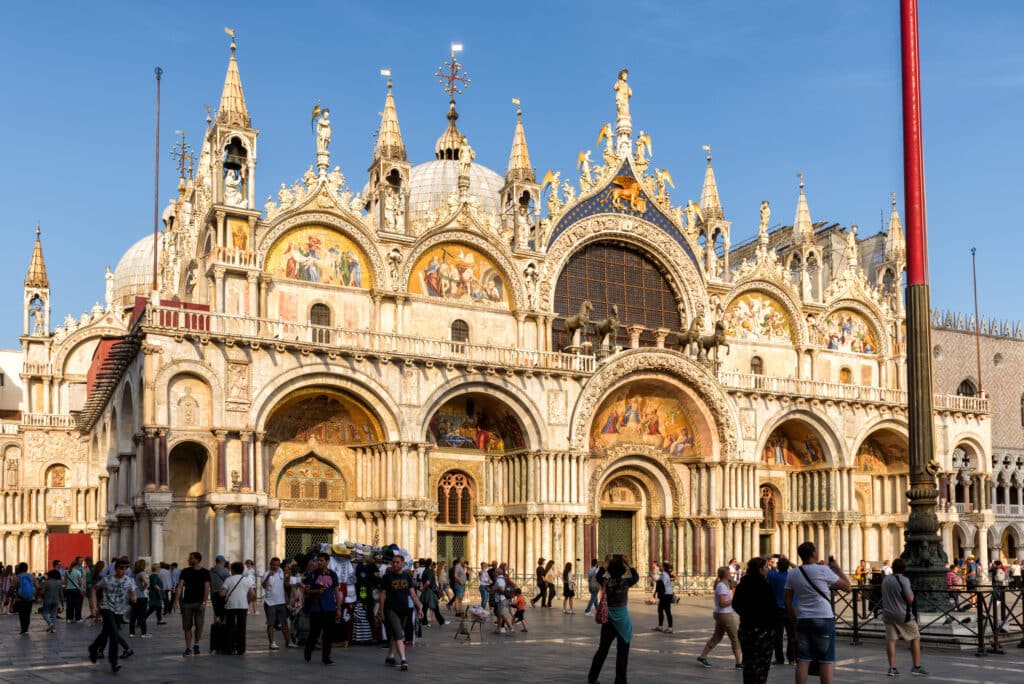
St. Mark’s Basilica, the crown jewel of Venice’s Piazza San Marco, now requires an entry ticket in 2025. The general admission fee is €3 per adult, while children under 6 years old enter for free. This basic ticket grants access to the basilica’s stunning main interior. Note that certain special areas inside have additional small charges: for example, viewing the Pala d’Oro (the magnificent golden altarpiece) costs an extra €5, and entry to the St. Mark’s Museum (which includes the Loggia dei Cavalli terrace with the famous bronze horses) costs €7; these supplements are likewise waived for children under 6. The Basilica’s visiting hours are typically 9:30 AM to 5:15 PM from Monday through Saturday (last entry at 4:45 PM), and 2:00 PM to 5:15 PM on Sundays and religious holidays.
These hours apply year-round, though in the quieter winter season (November through March) the queues are shorter and a reservation isn’t needed. During peak months (April to October) it’s wise to book a timeslot in advance to skip the legendary lines – in fact, from July 1, 2025, all tickets must be purchased online in advance, as on-site ticket booths will no longer operate. You can visit by obtaining a standalone ticket or as part of a guided tour (many combined tours include both St. Mark’s and the adjacent Doge’s Palace for convenience). Our team visited on June 25, 2025, and the information above was valid as of that date.
Inside the Golden Basilica: Art and History
St. Mark’s Basilica’s ornate facade and gilded domes earned it the nickname “Chiesa d’Oro,” meaning Church of Gold. Have you ever wondered why this Byzantine-style cathedral is so famous worldwide? The answer becomes clear as soon as you step inside. The interior is a breathtaking sight: virtually every surface is covered with shimmering mosaics – over 8,000 square meters of intricate, gleaming mosaic artwork adorn the walls and domes.
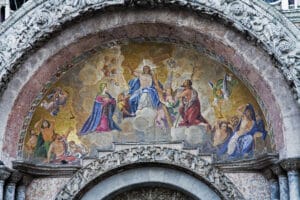
Detail above Doorway St Mark s Basilica, Venice, Italy

Interior of St Mark`s Basilica.
That is roughly the area of one and a half football fields blanketed in gold-tinted glass tesserae! Naturally, St. Mark’s Basilica is often called the “Golden Basilica”, and it’s easy to see why. The mosaics, crafted over the course of eight centuries, depict biblical scenes and the history of Venice in dazzling detail. We found ourselves constantly craning our necks to admire the ceilings, where sunlight filtering in makes the gold mosaics glow brilliantly at different times of day. It’s as if the entire church interior is basking in perpetual golden twilight – an atmosphere both peaceful and awe-inspiring.
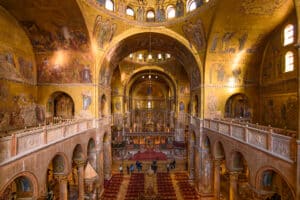
The mosaic decoration art of the interior of St Mark`s Basilica
Historically, this cathedral dates back to the 11th century (the present structure was largely completed by 1094), but its story begins even earlier with a bit of medieval piracy. How did St. Mark’s become Venice’s patron saint? In the 9th century, Venetian merchants famously stole the relics of St. Mark the Evangelist from Alexandria, hiding them in barrels of pork fat to smuggle them past guards.
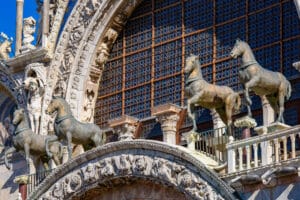
The Horses of Saint Mark
The remains of St. Mark were welcomed in Venice as heroic treasures. To honor them, the Doge ordered a grand church on this spot – and so the first basilica was built here, later evolving into the masterpiece we see today. The basilica’s design reflects Venice’s connections with the East: it was modeled after the great churches of Constantinople, resulting in a distinctive blend of Western and Byzantine architecture. Its facade is a masterpiece of Italo-Byzantine art, with five arched portals and multiple soaring domes. The exterior is richly decorated – for instance, above the central doorway stand the Four Bronze Horses of St. Mark, ancient statues looted from Constantinople in 1204 during the Fourth Crusade. (The ones you see outside today are replicas – the weathered originals, which date to antiquity, are kept inside the museum upstairs to protect them from the elements.)

Ancient bronze horses inside the Basilica San Marco, Venice.
Inside, the wow moments just keep coming. The basilica’s most precious treasure, in our opinion, is the Pala d’Oro – the “Golden Altar” screen behind the main altar. This gilded Byzantine masterpiece is studded with jewels; in fact, it holds literally hundreds of precious stones (over 1,300 pearls and hundreds of emeralds, sapphires, amethysts and garnets adorn its surface).
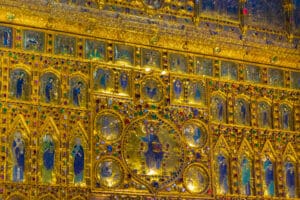
Pala d`Oro
We definately recommend paying the small extra fee to view the Pala d’Oro up close – it left us speechless with its craftsmanship and opulence. Another highlight not to miss is climbing up to the Museum and Loggia dei Cavalli. For that €7 supplement, we wandered through exhibits of mosaic fragments and the original bronze horses, then stepped out onto the loggia (balcony) just above the front entrance. The panoramic view from up there, overlooking Piazza San Marco and the lagoon, is unforgettable – we’re gonna remember that sweeping vista of Venice’s landmarks for years to come. (Keep your camera ready, as this terrace is one of the best photo spots in the city.) Typically, a visit inside St. Mark’s itself is relatively short – about 10 to 15 minutes is the norm due to the constant flow of visitors – but we took our time, moving slowly to appreciate each glittering dome and marble floor pattern. We’d recommend visiting earlier in the morning on a weekday if possible, when it’s a bit less crowded, so you can pause and absorb the atmosphere without feeling rushed. And do dress appropriately for a holy site: shoulders and knees should be covered (scarves or shawls come in handy for this), as the basilica enforces a modest dress code out of respect.
What struck us most about St. Mark’s Basilica is how layered with history it is. This cathedral has stood witness to nearly a millennium of Venetian glory – from medieval doges’ ceremonies to Napoleon’s occupation (Napoleon himself once referred to the surrounding St. Mark’s Square as “the finest drawing room in Europe”). In recognition of its cultural value, Venice and its Lagoon (including St. Mark’s Basilica) were inscribed as a UNESCO World Heritage Site in 1987.
Standing inside the basilica, we felt the weight of that heritage. The marble floors underfoot undulate slightly – a reminder that the city is slowly sinking and that the basilica’s foundation, built on wooden piles in a marsh, has subtly warped over centuries. Yet the splendor remains intact. As we stood beneath those golden domes, it was humbling to think of all the generations of craftsmen, worshippers, and travelers who have gazed at the same shimmering mosaics. We were utterly mesmerized, to say the least.
Beyond the Basilica: Doge’s Palace, Rialto Bridge & Nearby Tips
After admiring St. Mark’s, you’ll find that the surrounding area is rich with other must-see sights – all within easy walking distance. Adjoining the basilica on one side is the Doge’s Palace (Palazzo Ducale), another icon of Venice that we highly recommend visiting. This Gothic palace, recognizable by its pink Verona marble facade and delicate lattice of arches, was the seat of Venetian power for centuries. Inside, its grand halls are adorned with masterpieces by Tintoretto and Veronese, and the lavish Sala del Maggior Consiglio (Great Council Hall) will take your breath away with its gilded ceiling. A standard ticket to the Doge’s Palace costs around €25 (with various concessions for students and seniors) and it is open to visitors daily from roughly 9:00 AM to 6:00 PM.
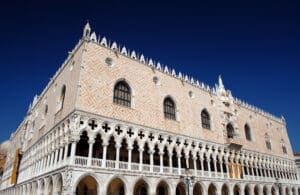
Palazzo Ducale
We toured the Palace right after the basilica – the entrance is just around the corner in the Piazzetta – and it was well worth the time. One memorable part of the Doge’s Palace tour is walking through the Bridge of Sighs. This enclosed, white-stone bridge connects the palace to the old prisons across the canal. As we crossed its narrow passage, we reflected on how condemned prisoners would sigh at their last view of Venice through the small stone-barred windows – an eerie and poignant piece of history. If you plan to see both the basilica and Doge’s Palace in one go, you might consider a combined “skip-the-line” tour or ticket; it can save time, since both attractions tend to have long queues. We visited at a leisurely pace, and by early afternoon we had experienced two of Venice’s greatest architectural gems back-to-back.
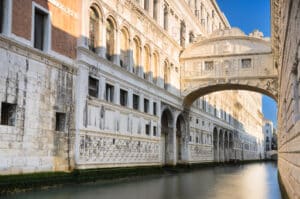
The famous Bridge of Sighs in Venice, Italy.
Not far from St. Mark’s (about a 10-minute stroll through charming shop-lined streets) lies another Venetian landmark: the Rialto Bridge. This elegant stone arch bridge spans the Grand Canal at its narrowest point and is the oldest bridge across the canal, dating to 1591. Before the 19th century, Rialto was the only way to cross the Grand Canal on foot, making it the bustling heart of Venice’s commercial district. Today it remains a lively hub – lined with small shops and usually filled with visitors taking photos of the canal. We walked over to Rialto Bridge in the late afternoon, and the view was simply magical. On one side, we watched gondolas and vaporettos gliding by on the green waters below; on the other, the sunset light was illuminating the facades of grand palazzos along the canal. It’s a great spot to feel the pulse of Venice. If you head that way, consider also exploring the open-air Rialto Market (in the mornings) on the San Polo side of the bridge, where locals buy fresh fish and produce – it adds a nice authentic touch alongside the historic tourist sights. By the time we left the square we realized just how much Venice packs into a small area.
After sightseeing, you might need a break to recharge. Thankfully, the St. Mark’s Square area and its surroundings offer plenty of options. If you’re looking to soak in the atmosphere of Piazza San Marco, you could relax at one of the historic cafés on the square – for instance, Caffè Florian or Gran Caffè Quadri. Sipping a coffee at Florian’s outdoor tables, listening to a live string quartet under the arcade, we felt like we had stepped back in time (just be aware that the prices at these famous cafes are quite high, essentially an “event” fee for the ambience). For a lighter snack or quick bite near the basilica, Ai Do Leoni is a convenient little spot – it’s a cafe located by the “Leon” entrance (the side door near the lion statues), where we grabbed tramezzini sandwiches and espresso at the counter. If you prefer a sit-down meal, there are many trattorias in the maze of streets between St. Mark’s and Rialto. We personally loved Osteria Enoteca San Marco, a tucked-away wine bar and restaurant just a few minutes from the basilica. It offered a welcome calm from the crowds and served excellent Venetian dishes and wines – we ate there on our visit and it ended up being one of our best meals in Venice. There’s nothing like unwinding with a good Italian wine after a long day of walking through history!
Finally, for those who want to cap off the St. Mark’s experience with something truly special, consider climbing the Campanile – the tall bell tower in St. Mark’s Square. A separate attraction from the basilica (tickets cost about €10), an elevator ride up the Campanile will reward you with a 360-degree panoramic view of Venice’s domes, rooftops and lagoon. We went up just before sunset and found it absolutely enchanting to see the city from above, bathed in golden light. It’s the perfect way to appreciate the city’s layout after exploring its treasures at ground level.
Visiting Venice St. Mark’s Basilica is not just about ticking off a single site – it’s an immersive journey into art, history, and the vibrant surroundings. We left with memories of golden mosaics, epic legends, and delightful moments shared over Venetian cuisine. We recommend adding St. Mark’s and its neighboring sights to your Venice itinerary – the Basilica and its vicinity truly offer an experience that captures the essence of La Serenissima.

